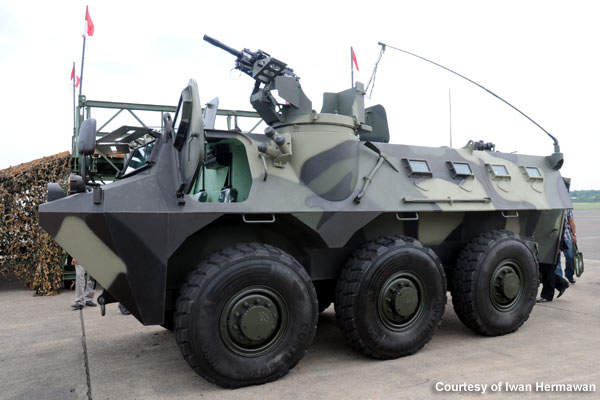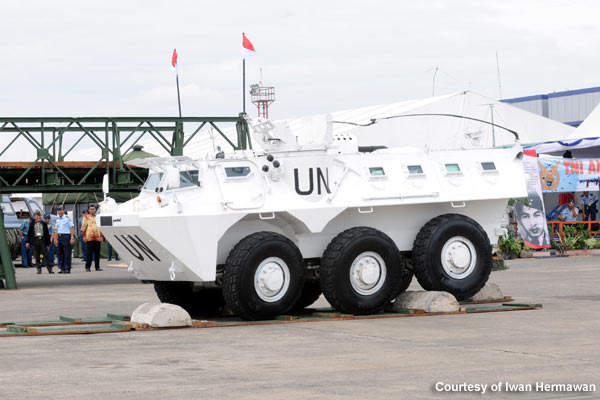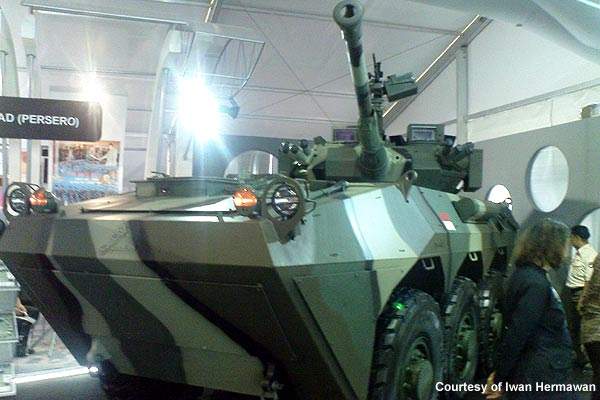The Panzer APS 6×6 armoured personnel carrier
The Panzer APS 6×6, a type of armoured personnel carrier (APC), is an armoured fighting vehicle whose primary function is to transport infantry to the battlefield. The Panzer was developed by PT Pindad, an Indonesian Government-run private organisation, which develops small arms and military vehicles. The vehicle is specifically designed for cavalry needs and can carry ten personnel, including three crew members, one driver, one commander and one gunner.
The APS was designed, engineered and developed by PT Pindad, who also provides the vehicle’s maintenance. The total value of the contract is Rp473bn ($51m).
Panzer APS 6×6 vehicle development
The history of the development of the Pindad Panser goes back to 2003 when the Indonesian Army put forward a requirement for an APC for transportation of infantry in Aceh province.
The APR-1V or Angkut Personel Ringan was the APC then developed by PT Pindad as a response to the requirement. It was developed and sent in 2004 to Aceh for the Indonesian Army to evaluate and perform combat trails on it.
The Agency for Assessment and Application of Technology (BPPT) assisted Pindad in the further development of the vehicle in 2005. The APS-1 or Angkut Personel Sedang was developed during this period.
Panzer APS 6×6 design
The driver of the Panzer APS 6×6 runs the vehicle sitting on the right side while the commander is seated on the left. The design of the hull of the vehicle is monocoque.
The design of the vehicle is different from that of its predecessors and the hull consists of armour steel. It incorporates a new torsion bar suspension system, which was developed exclusively.
APS mission variants
The first variant of the APS developed was the Angkut Personel Ringan (APR-1V) in 2004. It is a 4×4 armoured vehicle and possesses an Isuzu truck chassis.
The APS-1, a 6×6 vehicle based on a commercial Perkasa truck platform by PT Texmaco, was the next variant developed. The APS-1 was not selected for production.
When the Indonesian Army requested Pindad to develop the next-generation of Panser vehicles, the APS-2 came into development.
The APS-3, also known as Anoa, was first showcased at the Tentara Nasional Indonesia (TNI) parade on 5 October 2008. The TNI is the Indonesian national defence forces. Its prototype was unveiled in October 2006. The variant was officially unveiled at the Indo Defence & Aerospace 2008 exhibition.
Other variants are expected to be developed by Pindad, with plans to keep the APS 6×6 as the base model. The variants include fire support, ambulance, command, logistics, armoured recovery, reconnaissance and mortar carrier.
APS 6×6 vehicle orders and deliveries
Indonesia’s Ministry of Defence placed an order with PT Pindad for 150 units of APS-2 6×6 APCs, plus four armoured reconnaissance units, in 2008. By February 2010, Pindad had delivered a total of 93 units of APS-2 in three different stages or phases.
In the first stage of delivery, PT Pindad delivered 20 APS-2 (6×6) to the Indonesian Ministry of Defence in February 2009. The second stage followed on 7 July 2009 when PT Pindad delivered a further 40 APS-2 (6×6) to the Ministry of Defence.
On 13 January 2010, Pindad delivered 33 Panzer APC-2 6×6 to the Indonesian Ministry of Defence. Out of the 33 APCs, 20 will be used by the Indonesian Army, while the rest are planned to be deployed in Lebanon for peacekeeping duties.
The delivery of the remaining 61 APCs was completed by the end of 2010, with deliveries in a further two stages in July 2010 and September 2010.
Nepal, Malaysia, Bangladesh and Oman are known to have shown interest in the vehicle but there have been no confirmed orders with these countries yet.
Renault turbo-charged diesel engine
France-based automaker Renault currently supplies the engine and the transmission for the APS 6×6 vehicle, but other options are being considered and developed.
The type of engine used in the vehicle is the Renault MIDR 062045 six-cylinder turbo-charged diesel engine.
APS 6×6 vehicle armament
A cupola sits on the left side of the Panzer APS 6×6. The vehicle can be armed with either a machine gun or a grenade launcher.
The machine gun is a 12.7mm (.50 cal), while the grenade launcher is a 40mm automatic.
In addition, two types of heavy guns can be attached on the front and the rear of the vehicle. It is equipped with night vision and a winch of 6t capacity.
The communication facilities include VHF / FM (anti-jamming and hopping) and GPS.







